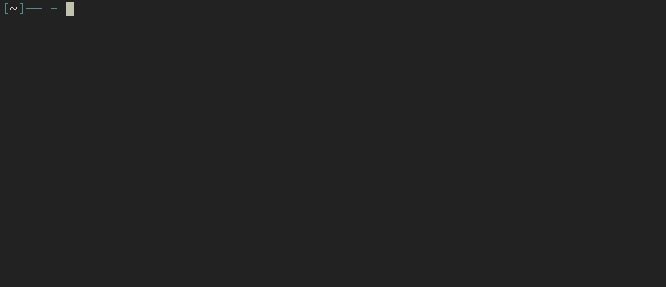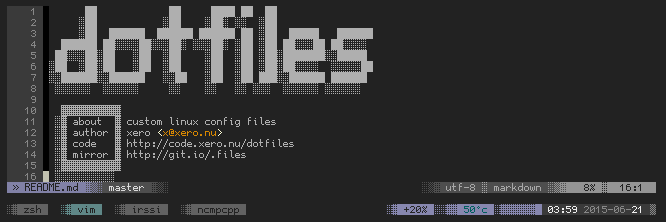vim
misc :: why i use an editor from the 1990s

contents
- editor vs ide
- simple
- everywhere
- vim
- help
- configurable
- extensible
- multiple files
- interface
- shell commands
- file searching
- random vim tips
- learning & tutorials
- wrap up

this is my arch linux install guide. it's not meant to replace the beginners guide or the install guide, but act as a quick overview of exactly what the install process entails. hopefully this will encourage those intimidated by the terminal only install process.
this setup is for my HP Envy 6t-1000 laptop. it has a 32gb ssd drive with two partitions for boot and / and the other 500gb hdd is my home. my laptop has plenty of ram so i do not use a swap. my laptop also has UEFI bios and will cover it's install procedure.
boot to the install medium and you will be greeted by the prompt:
root@archiso ~ # in the unix world programs are commonly configured in two different ways, via shell arguments or text based configuration files. programs with many options like text editors are configured on a per-user basis with files in your home directory ~. in unix like operating systems any file or directory name that starts with a period or full stop character is considered hidden, and in a default view will not be displayed. thus the name dotfiles.
in the unix world programs are commonly configured in two different ways, via shell arguments or text based configuration files. programs with many options like text editors are configured on a per-user basis with files in your home directory ~. in unix like operating systems any file or directory name that starts with a period or full stop character is considered hidden, and in a default view will not be displayed. thus the name dotfiles.
it's been said of every console user:
you are your dotfiles
ok, i said that ;P
since they dictate how your system will look and function.
i manage mine with gnu stow, a free, portable, lightweight symlink farm manager. this allows me to keep a versioned directory of all my config files that are virtually linked into place via a single command....
atom is a "hackable text editor for the 21st century" created by the team at github. it's designed to be customizable, but also usable without needing to edit a config file.
because we spend most of our day in a text editor, the single most important feature we wanted in an editor was extensibility. atom is built with the same open source technologies used by modern web browsers. at the core of atom is chromium, the open source project behind google chrome. with that comes all the power and innovation being developed for the web. but more importantly, extending atom is as simple as writing javascript and css, two languages used by millions of developers each day.
atom.io
cron jobs are automated scripts that run at a specified date/time, or on a specified interval.
anything that can be executed in the terminal on the server can be run as a cron job (this includes commands, applications, scripts, etc).
crontab is the command used to create/view/modify/remove cron jobs.
once the crontab file has been edited the cron daemon will automatically read it and update it's job que to match the file. you should see the message:
crontab: installing new crontab
switching to from windows to linux is one of the best choices i have made in years. the freedom it provides is unparalleled. the fact that it's 100% free, the open nature of it's development, the community focus, and the abundance of free software was enough to convince me to give it a try.
